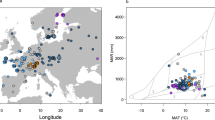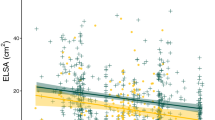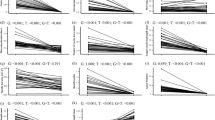Abstract
Because plants depend on light for growth, their development and physiology must suit the particular light environment. Plants native to different environments show heritable, apparently adaptive, changes in their response to light1,2. As a first step in unraveling the genetic and molecular basis of these naturally occurring differences, we have characterized intraspecific variation in a light-dependent developmental process—seedling emergence. We examined 141 Arabidopsis thaliana accessions for their response to four light conditions, two hormone conditions and darkness. There was significant variation in all conditions, confirming that Arabidopsis is a rich source of natural genetic diversity. Hierarchical clustering revealed that some accessions had response patterns similar to known photoreceptor mutants, suggesting changes in specific signaling pathways. We found that the unusual far-red response of the Lm-2 accession is due to a single amino-acid change in the phytochrome A (PHYA) protein. This change stabilizes the light-labile PHYA protein in light and causes a 100-fold shift in the threshold for far-red light sensitivity. Purified recombinant Lm-2 PHYA also shows subtle photochemical differences and has a reduced capacity for autophosphorylation. These biochemical changes contrast with previously characterized natural alleles in loci controlling plant development, which result in altered gene expression or loss of gene function3,4,5,6,7,8,9.
This is a preview of subscription content, access via your institution
Access options
Subscribe to this journal
Receive 12 print issues and online access
$209.00 per year
only $17.42 per issue
Buy this article
- Purchase on Springer Link
- Instant access to full article PDF
Prices may be subject to local taxes which are calculated during checkout





Similar content being viewed by others
References
Dudley, S.A. & Schmitt, J. Genetic differentiation in morphological responses to simulated foliage shade between populations of Impatiens capensis from open and woodland sites. Funct. Ecol. 9, 655–666 (1995).
Schmitt, J., Dudley, S.A. & Pigliucci, M. Manipulative approaches to testing adaptive plasticity: phytochrome-mediated shade-avoidance responses in plants. Am. Nat. 154, S43–S54 (1999).
Doebley, J., Stec, A. & Hubbard, L. The evolution of apical dominance in maize. Nature 386, 485–488 (1997).
Michaels, S.D. & Amasino, R.M. FLOWERING LOCUS C encodes a novel MADS domain protein that acts as a repressor of flowering. Plant Cell 11, 949–956 (1999).
Cubas, P., Vincent, C. & Coen, E. An epigenetic mutation responsible for natural variation in floral symmetry. Nature 401, 157–161 (1999).
Frary, A. et al. fw2.2: a quantitative trait locus key to the evolution of tomato fruit size. Science 289, 85–88 (2000).
Fridman, E., Pleban, T. & Zamir, D. A recombination hotspot delimits a wild-species quantitative trait locus for tomato sugar content to 484 bp within an invertase gene. Proc. Natl Acad. Sci. USA 97, 4718–4723 (2000).
Johanson, U. et al. Molecular analysis of FRIGIDA, a major determinant of natural variation in Arabidopsis flowering time. Science 290, 344–347 (2000).
Yano, M. et al. Hd1, a major photoperiod sensitivity quantitative trait locus in rice, is closely related to the Arabidopsis flowering time gene CONSTANS. Plant Cell 12, 2473–2484 (2000).
Neff, M.M., Fankhauser, C. & Chory, J. Light: an indicator of time and place. Genes Dev. 14, 257–271 (2000).
Cashmore, A.R., Jarillo, J.A., Wu, Y.J. & Liu, D. Cryptochromes: blue light receptors for plants and animals. Science 284, 760–765 (1999).
Briggs, W.R. et al. The phototropin family of photoreceptors. Plant Cell 13, 993–997 (2001).
Asami, T. & Yoshida, S. Brassinosteroid biosynthesis inhibitors. Trends Plant Sci. 4, 348–353 (1999).
Sharbel, T.F., Haubold, B. & Mitchell-Olds, T. Genetic isolation by distance in Arabidopsis thaliana: biogeography and postglacial colonization of Europe. Mol. Ecol. 9, 2109–2118 (2000).
Johnson, F.S., Mo, T. & Green, A.E. Average latitudinal ultraviolet radiation at the earth's surface. Photochem. Photobiol. 23, 179–188 (1976).
Alonso-Blanco, C., Blankestijn-de Vries, H., Hanhart, C.J. & Koornneef, M. Natural allelic variation at seed size loci in relation to other life history traits of Arabidopsis thaliana. Proc. Natl Acad. Sci. USA 96, 4710–4717 (1999).
Clough, R.C. & Vierstra, R.D. Phytochrome degradation. Plant Cell Environ. 20, 713–721 (1997).
El-Din El-Assal, S., Alonso-Blanco, C., Peeters, A.J.M., Raz, V. & Koornneef, M. A QTL for flowering time in Arabidopsis reveals a new allele of CRY2. Nature Genet. 29, '–' (2001).
Weigel, D. et al. Activation tagging in Arabidopsis. Plant Physiol. 122, 1003–1013 (2000).
Ihaka, R. & Gentleman, R. R. A language for data analysis and graphics. J. Comput. Graph. Stat. 5, 299–314 (1996).
Pinheiro, J.C. & Bates, D.M. Mixed-effects Models in S and S-PLUS (Springer, New York, 2000).
Robertson, A. The sampling variance of the genetic correlation coefficient. Biometrics 15, 469–485 (1959).
Eisen, M.B., Spellman, P.T., Brown, P.O. & Botstein, D. Cluster analysis and display of genome-wide expression patterns. Proc. Natl Acad. Sci. USA 95, 14863–14868 (1998).
Schumacher, K. et al. The Arabidopsis det3 mutant reveals a central role for the vacuolar H(+)-ATPase in plant growth and development. Genes Dev. 13, 3259–3270 (1999).
Lin, C. et al. Enhancement of blue-light sensitivity of Arabidopsis seedlings by a blue light receptor cryptochrome 2. Proc. Natl Acad. Sci. USA 95, 2686–2690 (1998).
López-Juez, E. et al. The cucumber long hypocotyl mutant lacks a light-stable phyB-like phytochrome. Plant Cell 4, 241–251 (1992).
Nagatani, A., Yamamoto, K.T., Furuya, M., Fukumoto, T. & Yamshita, A. Production and characterization of monoclonal antibodies which distinguish different surface structures of pea (Pisum sativum cultivar Alaska) phytochrome. Plant Cell Physiol. 25, 1059–1068 (1984).
Murphy, J.T. & Lagarias, J.C. Purification and characterization of recombinant affinity peptide-tagged oat phytochrome A. Photochem. Photobiol. 65, 750–758 (1997).
Yeh, K.C. & Lagarias, J.C. Eukaryotic phytochromes: light-regulated serine/threonine protein kinases with histidine kinase ancestry. Proc. Natl Acad. Sci. USA 95, 13976–13981 (1998).
Alonso-Blanco, C. et al. Development of an AFLP based linkage map of Ler, Col and Cvi Arabidopsis thaliana ecotypes and construction of a Ler/Cvi recombinant inbred line population. Plant J. 14, 259–271 (1998).
Acknowledgements
We thank U. Genick, S. Harmer and J.C. Lagarias for insightful discussion, J.C. Lagarias for Avena PHYA expression constructs, and J. Werner for help with hypocotyl measurements. Seeds were obtained from the Arabidopsis Biological Resource Center (ABRC) at Ohio State University, which is funded by NSF. The joint program in quantitative genetics in the Weigel and Chory laboratories is supported by NIH training grant GM08666 (J.O.B.), by a Helen Hay Whitney Fellowship (J.N.M.), funds from the HHMI and NIH (GM52413) to J.C. and by a grant from Torrey Mesa Research Institute/Syngenta to D.W. D.W. is a Director of the Max Planck Institute. J.C. is an Associate Investigator of the HHMI.
Author information
Authors and Affiliations
Corresponding author
Supplementary information
Rights and permissions
About this article
Cite this article
Maloof, J., Borevitz, J., Dabi, T. et al. Natural variation in light sensitivity of Arabidopsis. Nat Genet 29, 441–446 (2001). https://doi.org/10.1038/ng777
Received:
Accepted:
Published:
Issue Date:
DOI: https://doi.org/10.1038/ng777
This article is cited by
-
The interaction between titanium dioxide nanoparticles and light can have dualistic effects on the physiological responses of plants
Environmental Science and Pollution Research (2024)
-
Indirect genetic effects are shaped by demographic history and ecology in Arabidopsis thaliana
Nature Ecology & Evolution (2023)
-
A phytochrome-B-mediated regulatory mechanism of phosphorus acquisition
Nature Plants (2018)
-
Analysis of T-DNA alleles of flavonoid biosynthesis genes in Arabidopsis ecotype Columbia
BMC Research Notes (2012)
-
Sequence analysis of the Microcystis aeruginosa FACHB-912 phytochrome gene supports positive selection in cyanobacteria
Chinese Science Bulletin (2012)



